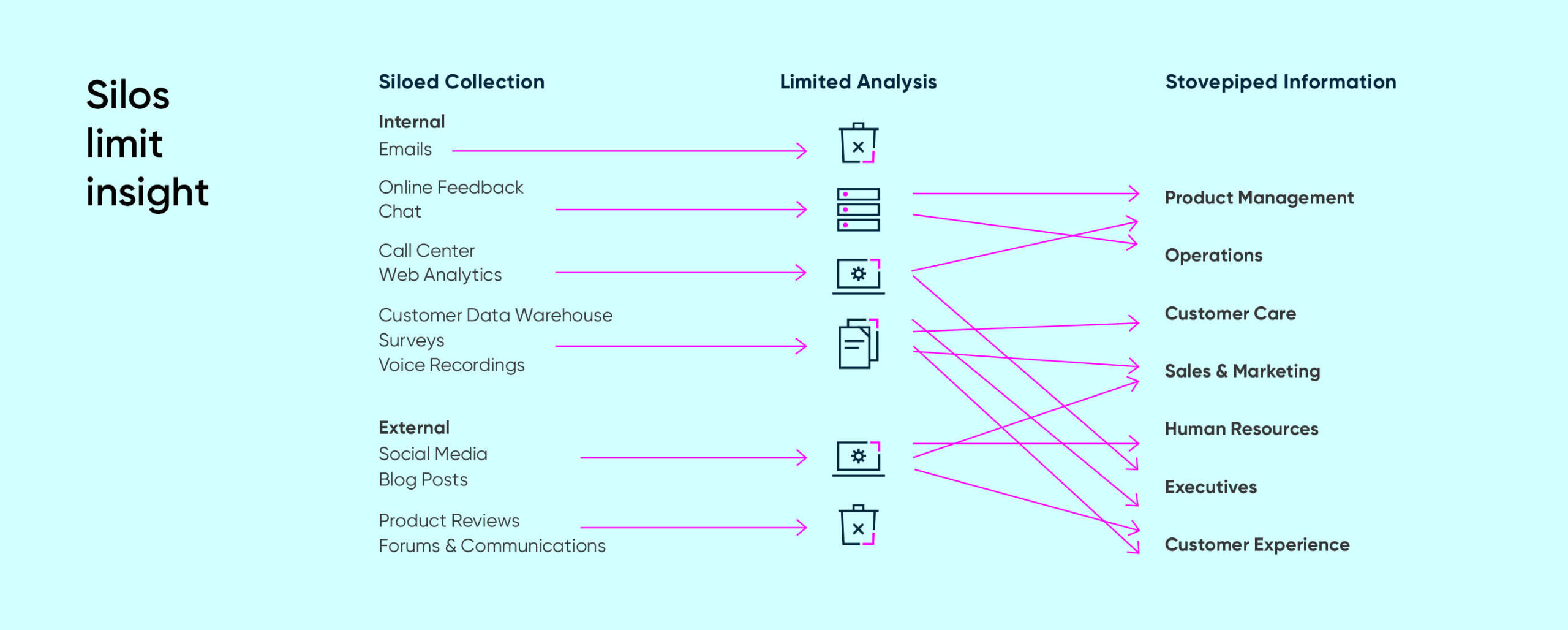Text analytics in CX

The business benefits of a customer experience program have been proven by a wide range of organizations who have embraced the Voice of the Customer early, including:
- Spotting new delivery issues early
- Identifying emerging trends
- Reducing operational costs by addressing common customer support issues
- Developing product innovations based on the wealth of customers’ ideas
- Understanding the root causes of customer satisfaction scores.
- Components of a Customer
All these combine to generate real ROI, improve the bottom line and ensure your business remains on the true Voice of the Customer through the inclusion of free-form data, categorized by the latest text analytics technology which has brought the elusive single view of the customer firmly within reach.
As we have all witnessed on YouTube, ignoring the complaints of an influential customer can quickly become a PR disaster of global proportions!
Key components of a Customer Experience program
1
Listen to the Voice of the Customer
2
Interpret customer data to extract meaningful information and find hidden truths
3
Deliver actionable insights and personalized reporting
4
Measure and track metrics and trends over time, to continuously improve the program and drive the customer experience
Introduction
Today’s successful companies have already implemented a customer experience program in one form or another.
Some of them might even be considered mature in their approach, meaning they have taken their program beyond the simple listening and measuring phases, to actually responding to customers, taking action and delivering real insights across the organization. For customer experience professionals, the next challenge is to evolve their program in both depth and breadth, towards true brand-experience differentiation.
In order to achieve this, there is one area which they need to resolve efficiently and systematically: how to deal with free-form, unstructured data and analyze text from various sources in a meaningful and measurable way. The exponential rise in the volume of this type of data – whether it is solicited (e.g. survey verbatims) or not (e.g. customer forums, social media sites, etc.) – leads to the inevitable conclusion that it can no longer be ignored if companies want to stay on top. Text is, after all, the primary method used for recording thoughts and feelings, and for expressing ideas and reasoning. And more than ever before, customers are finding they have a voice, and it matters!
Tip
Get your first step right and ensure you select the right partner:
Identify the relevant data sources, choose a robust, scalable and most of all integrated software solution, and prioritize available resources. You need to establish these things (and more!) upfront to put you in the best position as you move forward t
There are many reasons why most brands have, so far, focused mostly on structured data: it is far easier to collect, measure, and analyze. Responding to a customer who just submitted a survey is also far easier than being present on all online forums, ready at all times to take on any issues that might come up, anywhere. For most, this seems like an unattainable goal, but it isn’t. With the advance of text analytics software solutions, you can be everywhere at the same time, listening to everyone, and you can then make the right investments to respond and act on this feedback.
To claim to have a true Voice of the Customer program, you need to listen to the actual voice, in all its forms, and manage all customer 02 feedback centrally, in order for it to make sense and deliver what you really need: the insights necessary to make sound business decisions, distributed to the right people, at the right time. True leaders are those who will 04 unlock the potential of unstructured data, as well as their structured data and translate it into business value, day after day, across the entire rganization. A customer experience program, backed by a robust text analytics solution, is critical in achieving this goal. This white paper is intended to provide guidance about the key elements of such programs, and focused on four key components:
“Our research shows that the leading VoC programs are using text analytics to reshape their VoC programs,” the Temkin Group wrote in a recent report. “We believe that this up and coming capability will transform all aspects of the VoC competencies.”
A statistical approach to sentiment analysis
Forsta employs state-of-the-art statistical analysis techniques for analyzing text to determine categories for the text and assessing the sentiment within each category. Processing language using a statistical approach has many advantages:
- More adaptable: learns from the text provided so quickly and easily adapts to different styles of content
- Faster performance: For high volumes of text, such as social media or large-scale surveys, the performance of the sentiment analysis becomes critical and statistical approaches perform much faster
- More forgiving: statistical approaches learn from the example text provided, and so can be more forgiving of poor grammar or spelling
- Language agnostic: adding a new language just requires the availability of a corpus of text plus linguistic knowledge to provide the seed words for positive and negative sentiment – there’s no need to develop the software to handle the different grammatical rules of each different language.
1. Listen to the Voice of the Customer
According to analyst firm, Gartner, “Unstructured content represents as much as eighty percent of an organization’s total information assets.” (1) And it is often where the real knowledge gems remain dormant:
- Do you have insight into what your customers and partners are saying about you?
- Why do customers rate your product or services a certain way?
- What future innovations lie unchecked in your customer forums?
- What critical issues have been uncovered in Twitter and threaten both your customers’ loyalty – and your bottom line?
- What is a product or service issue that could cause a PR disaster?
Companies spend millions of dollars every year collecting feedback from their customers, whether through their own feedback programs or their Market Research agencies. And it is critical data. Yet these same companies often have no way of tapping into the vast majority of customer feedback, all of it available just beyond their reach. Customers have taken over the conversation, and to succeed brands need to know how to join in, rather than try and control it, and understand what customers are really saying.
Accuracy is everything
In an Amazon review test, the sentiment analysis technology used by Forsta achieved nearly 90% accuracy when comments were compared to star ratings.
This is the same accuracy as is achieved by humans.
More than ever, the sheer volume of data sources, such as survey verbatims, customer forums, social media sites, reviews, contact center notes, and emails, and types – text, audio, video, SMS – has organizations and Market Research companies constantly striving to keep up. Where to look for the data and how to monitor it have become real challenges. The exponential growth in the volume and importance of unstructured data, both solicited and unsolicited, has encouraged best-in-class organizations to embrace text analytics as a complementary tool to customer experience programs, in order to retain their competitive advantage. Having the right technology and methodology are now critical. So is the need to hold all this information in a single hub to achieve a single view of the customer and deliver actionable insights to the organization.
“Consumers are in the midst of a conversation that isn’t ours. The race is on to grow ears to learn what they are saying.”
John Hayes
Chief Marketing Officer, American Express
Historically handled on an ad-hoc basis, with employees manually coding survey verbatims, for example, unstructured data has been largely neglected, and there has been limited resource spent on gathering representative, accurate and measurable information from these sources. The main issues with dealing with the unstructured data are both technological and methodological. On the technological side, historically, the right tools have not existed to tackle the issue in the first place. Now, however, text analytics software has caught up with companies’ needs and it has enabled many of them, to derive not only customer feedback, but competitive intelligence, business insights, product innovations, and more.
While text analytics has solved the challenges behind the collection, identification, coding, analysis, and interpretation of full text content from a variety of sources, it is not enough to decide to go after these largely untapped wells of intelligence. You also need to establish a methodology which will help deliver the insight you need.
2. Interpret customer data to extract meaningful information
The next challenge is how to make sense of all the data that you have collected from the multitude of sources: internal and external, solicited or not. This is where text analytics really becomes a critical component of a successful customer experience program. Modern text analytics has been proven to be more reliable, faster, easier to analyze, and more cost- efficient than manual methods.
Text analytics can map the meaning of any textual content to reveal customer sentiments, concerns, intentions, and ideas, clearly and reliably. In effect it transforms unstructured text into structured data that can then be used to understand and predict customer behavior, using for example, multivariate or logistic regression, cluster analysis or modeling techniques. Basically, text analytics quantifies and analyzes textual information in real time to generate immediate, actionable insights.
By using a solution that integrates with your wider customer experience program, you can divide this data into sentiment categories, themes, emerging issues, and root causes and use that insight to drive action.
Take for example a hotel chain that processes 250,000 guest surveys every quarter. The survey is intentionally short, with a customer satisfaction score and an open-ended question, “Why have you given this score?”.
Tip
Start small and build up as you improve accuracy
The volume and variety of text sources mean that it’s usually best to start by analyzing text from one or two sources so you can fine- tune your categories and ensure accuracy. Consider starting with survey verbatim so you can compare sentiment generating by your text analytics solution with actual rating scores provided by customers. Then you’re in a better position to roll out your analysis further.
The answers to this question might talk about service, cleanliness, billing, surroundings, food, even pillow quality, or more likely, a combination of these. And the sentiment behind these criteria might be positive, negative, or again a combination. For example, “service was excellent, but I was overcharged for the mini-bar”.
This is where text analytics works its magic; categorizing comments into concepts and assigning sentiment, or “qualifiers”. By integrating this data into other customer experience analysis, this hotel chain can not only analyze customer satisfaction trends quarter on quarter, but also understand the underlying causes for loyalty or dissatisfaction.
The power of extracting meaning out of survey verbatim is only a small part of what text analytics can achieve. Imagine all the conversations that are happening right now involving your customers and prospects. Even if you have a monitoring platform that allows you to join in the conversation, what are you doing to “record” it, extract its key meaning, integrate it with the rest of your data, and report on it? Most organizations think it is simply too complex, but technology has now made it within their reach, whatever their size or resources.

3. Deliver actionable insights and personalized reporting
So you have now unearthed and interpreted a vast amount of data, the million-dollar question is, what are you going to do with it?
There are generally two ways to react to customer feedback, whatever its form:
Take immediate action and close the loop
with your customers, by showing their feedback has been received and taken into account
Aggregate the data by type, region, customer segment, etc.
and get an overall picture of the key issues that customers face, in order to make long term business decisions.
It is generally advised in most industries that both methods, often characterized as operational and strategic, be used in conjunction with each other for maximum efficiency.
Tip
Start small and build up as you improve accuracy
The volume and variety of text sources mean that it’s usually best to start by analyzing text from one or two sources so you can fine- tune your categories
and ensure accuracy. Consider starting with survey verbatim so you can compare sentiment generating by your text analytics solution with actual rating
scores provided by customers. Then you’re in a better position to roll out your analysis further.
Operational actions
By combining structured and unstructured data and accessing it in the right format, employees on the front line can quickly act on customer feedback. The obvious example is when a dissatisfied customer sends back a survey complaining about the quality of a product he has just purchased. By setting up alerts within your customer experience program and using text analytics to predetermine the specific issue, the right front-line employee will receive an automated e-mail and will be able to deal quickly and efficiently with this customer. Leading brands have already caught on with the immense benefits of “operationalizing the data” in this way – making it a part of every employee’s workflow and ensuring customer experience stays at the top of everyone’s agenda, no matter where they sit within the organization.
Dealing with unsolicited data poses greater challenges than verbatim in a survey. Organizations today may run customer forums, social media sites, and blogs, but how can they continuously tap into the “chatter” online, and empower their employees to respond? A customer experience program backed by text analytics will deliver the right information to the right people (Fig. 1), although it does raise further issues, including human resources, operations, and customer support, for example. And as we have all witnessed on YouTube, ignoring the complaints of an influential customer can quickly become a PR disaster of global proportions!
Structural improvements
Issues are rarely created in a silo, so analyzing them purely in the context of a single department is ill-advised. For example a low satisfaction score in customer service might actually stem from a widespread product defect, or a delivery issue. Extracting insights from the volume of data is what the organization needs, to make informed strategic decisions about structural improvements. The last thing the CEO wants to do is make a significant investment based on incomplete data. This is why the data, and the insights it generates, needs to serve as a catalyst for a cross- functional, customer-centric approach. Not just some of the data, when it’s convenient or easier to collect and visualize – but the whole picture that the data indicates. And only an integrated customer experience solution backed by powerful text analytics can deliver this in a reliable, meaningful, representative and cost- efficient way.
Another issue here is how to prioritize which feedback to respond to. For most organizations, especially in Business to Consumer (B2C), it is simply not possible to respond to all feedback, one customer at a time. So how to tackle this issue? In most cases, they take an inside-out approach based on their resources, departmental processes and available technologies. Rarely do they take a customer- centric approach. Companies engaged in a successful customer experience program know one of the necessary steps at the start is to design the customer journey, and to build their feedback collection and closed-loop process around the touch points of that journey.
A truly powerful customer experience program, integrated with text analytics enables companies to combine the business benefits of both operational and structural improvements. They can identify front-line actions in order to save at-risk customers in the short term, and through advanced reports, they are able to make viable decisions about long-term customer investments that will yield solid Return on Investment (ROI).

4. Measure and track metrics and trends over time
“What gets measured gets managed.” This saying is truer today than it has ever been. It is also one of the reasons that text data has not been treated quite the same way as quantitative data. Without the proper means to extract meaning, trends and metrics out of it, it has simply been ignored, or at best, used to illustrate scores and business metrics. Text analytics has changed that, by converting text into a measurable entity, which can then sit intelligently alongside financial KPIs and loyalty metrics, and furthermore, make sense out of them.
A fundamental building block of a customer experience program revolves around choosing the right metrics for the organization. And understanding the economic impact of these metrics going up or down is essential to ensuring growth and profitability. But focusing solely on the score is a fundamental mistake, and a trap that many organizations still fall into. If the birth of customer experience as a discipline revolved around the right metrics, the future lies in the “why” and the “how” behind the score. Indeed, without a clear and representative analysis of what needle to move, (i.e. what customers really feel and think), how do you know where to invest to ensure the metric is going to move in the right direction, and at the right speed? As always it’s about ROI – and text has a prime part to play in this never-ending quest. The key to success is to ensure this is part of a continuing process that must be reviewed and developed over time, in order to remain up-to-date with the changing behavior of customers.
Text analytics not only delivers business insights out of information, chatter, and opinions, it also delivers metrics and trends, and adds a critical dimension to your quantitative data. And it represents a key component of what some believe to be the holy grail of customer experience: the single view of the customer. Integrating all data, structured and unstructured, solicited or not, with your CRM and CEM platforms, delivers the perfect 360-degree view, from the company’s and from the customer’s points of view. All this to drive sound business decisions, based on powerful, yet intuitive analysis of unlimited volumes of quantitative and qualitative data gathered and analyzed together.
Tip
Use free-form text to identify future metrics
As your program and business evolves, the metrics that matter might shift over time. Use the insight you gain from verbatims and unsolicited comments to understand which issues really matter to customers and work to build those things into your measurement process.
Related resources
Getting the balance right for KS&R
Getting the balance right for KS&R Tools used How we helped market research firm KS&R balance keeping their tailor-made approach to research with saving their people time. The challenge Creating custom-made research despite market pressures KS&R needed more than a standard survey solution. Their research required rich customization, razor-sharp methodologies, and the flexibility to reflect real-world decision-making. Off-the-shelf […]

Seamless success: How Harris Poll delivers excellence with Research HX
Seamless success: How Harris Poll delivers excellence with Research HX Seamless success: How Harris Poll delivers excellence with Research HX Harris Poll is a trailblazer in market research, offering clients a blend of custom research, syndicated studies, and thought leadership. From brand tracking and message testing to ad effectiveness studies, their work delivers the insights […]

Everything you need to know about buying market research software
Everything you need to know about buying market research software Webinar synopsis: Tune in for a deep dive into the smartest way to evaluate, select, and secure the right research technology for your organization. We will expose the most common pitfalls, break down the key buying criteria, and show you how to build a rock-solid […]

Learn more about our industry leading platform
FORSTA NEWSLETTER
Get industry insights that matter,
delivered direct to your inbox
We collect this information to send you free content, offers, and product updates. Visit our recently updated privacy policy for details on how we protect and manage your submitted data.